
List of British Rail diesel multiple unit classes
Encyclopedia
This is a list of British Rail diesel multiple unit classes.
For a historical overview of multiple unit
development in Great Britain, see British diesel and electric multiple units
.
For a historical overview of multiple unit
Multiple unit
The term multiple unit or MU is used to describe a self-propelled carriages capable of coupling with other units of the same or similar type and still being controlled from one driving cab. The term is commonly used to denote passenger trainsets consisting of more than one carriage...
development in Great Britain, see British diesel and electric multiple units
British diesel and electric multiple units
'Multiple Unit' is a term used to describe a train which does not have a separate locomotive. Typically these are passenger trains with accommodation in every vehicle and motors or engines distributed under the floor along the length of the train...
.
Early BR DMUs (79xxx series)
| Manufacturer | Engines (per motor car) | Transmission | Type | Image |
|---|---|---|---|---|
| BR Derby 'Lightweight' British Rail Derby Lightweight The British Rail Derby Lightweight diesel multiple units, were the first such trains to be built en-masse for British Railways. The units were built at BR's Derby Works from 1954 to 1955. The units were built in various formations, including 12 power-twin 2-car units, 84 power-trailer 2-car units,... |
2 x Leyland 125 bhp or 2 x AEC 150 bhp | hydraulic (2 car) or mechanical (single car) | low density |  |
| Metro-Cammell 'Lightweight' British Rail Metro-Cammell In 1955, Metropolitan Cammell produced its first lightweight Diesel multiple units, the prototypes of what were to become British Rail's most successful and longest-lived First Generation DMU type, the Class 101.- Operations :... |
2 x AEC 150 bhp | mechanical | low density |  |
| AC Cars Railbuses | 1 x AEC 150 bhp | mechanical | railbus | 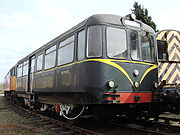 |
| Bristol-ECW Railbuses | 1 x Gardner 112 bhp | mechanical | railbus | http://www.railcar.co.uk/hisOthers/bristolintro.htm |
| Park Royal Railbuses | 1 x AEC 150 bhp | mechanical | railbus | http://www.railcar.co.uk/hisOthers/PRops.htm |
| Waggon und Maschinenbau Railbuses | 1 x Buessing 150 bhp | mechanical | railbus |  |
| Wickham Railbuses | 1 x Meadows 105 bhp | mechanical | railbus |
First Generation
TOPS classes| Class | Manufacturer | Engines (per motor car) | Transmission | Type | Image |
|---|---|---|---|---|---|
| Class 100 British Rail Class 100 The British Rail Class 100 diesel multiple units were built by Gloucester Railway Carriage and Wagon Company Limited from 1956 to 1958, designed and built in collaboration with the Transport Sales Dept. of T.I. Ltd.-Introduction:... |
Gloucester RC&W | 2 x AEC 150 bhp | mechanical | low density | 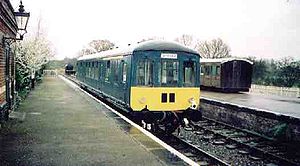 |
| Class 101 British Rail Class 101 The British Rail Class 101 diesel multiple units were built by Metro-Cammell at Washwood Heath in Birmingham from 1956 to 1959, following construction of a series of prototype units. This class proved to be the most successful and longest-lived of all BR's First Generation DMUs, with the final five... |
Metro-Cammell | 2 x AEC 150 bhp | mechanical | low density |  |
| Class 102 | Metro-Cammell | 2 x Leyland 150 bhp | mechanical | low density |  |
| Class 103 British Rail Class 103 The British Rail Class 103 diesel multiple units were built by Park Royal Vehicles with diesel engines by British United Traction . Ordered in the first half of 1955, 20 of these sets were built by Park Royal at the Crossley Motors works in Stockport of the ACV Group. They consisted of a power car... |
Park Royal | 2 x AEC 150 bhp | mechanical | low density | http://img175.imageshack.us/img175/4888/1994hh7.jpg |
| Class 104 British Rail Class 104 The British Rail Class 104 diesel multiple units were built by Birmingham Railway Carriage and Wagon Company from 1957 to 1959.The first units ordered were for the London Midland Region, with the majority of the class for use in North West of England with sets also in Tyneside... |
Birmingham RC&W | 2 x Leyland 150 bhp | mechanical | low density |  |
| Class 105 British Rail Class 105 The British Rail Class 105 diesel multiple units were built by Cravens Ltd. of Sheffield from 1956 to 1959. The class were built with a side profile identical to British Railways Mark 1 carriage stock, using the same doors and windows. None were selected for refurbishment... |
Cravens | 2 x AEC 150 bhp | mechanical | low density |  |
| Class 106 | Cravens | 2 x Leyland 150 bhp | mechanical | low density | |
| Class 107 British Rail Class 107 The British Rail Class 107 diesel multiple units were built by the Derby Works of British Railways and were introduced in 1960. The class looked similar to the later Class 108 units, but were heavier - having been built out of steel.-Usage:... |
BR Derby 'Heavyweight' | 2 x AEC 150 bhp | mechanical | low density | .jpg) |
| Class 108 British Rail Class 108 The British Rail Class 108 diesel multiple units were built by BR Derby from 1958 to 1961, with a final production quantity of 333 vehicles.... |
BR Derby 'Lightweight' | 2 x Leyland 150 bhp | mechanical | low density | 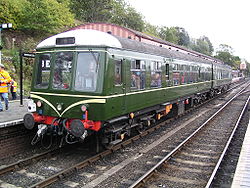 |
| Class 109 British Rail Class 109 The British Rail Class 109 is a class of 2-car diesel multiple units built in 1957 by D Wickham & Co. Five two-car units were built featuring an unusual body design.... |
Wickham | 2 x Leyland 150 bhp | mechanical | low density |  |
| Class 110 British Rail Class 110 The Class 110 diesel multiple units were built by the Birmingham Railway Carriage and Wagon Company in conjunction with the Drewry Car Co. to operate services on the former Lancashire and Yorkshire main line, and spent their entire careers based around this same area. This earned them the name of... |
Birmingham RC&W 'Calder Valley' | 2 x Rolls Royce 180 bhp | mechanical | low density |  |
| Class 111 British Rail Class 111 The Class 111 DMUs were based on Class 101/2s, but with different engines. The only external body difference was on the final batch of cars where a four character headcode box was fitted above the front cab windows, with the destination indicator on top of a reduced height centre window.The first... |
Metro-Cammell | 2 x Rolls Royce 180 bhp | mechanical | low density | 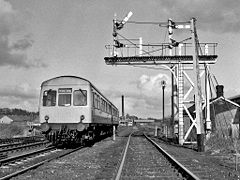 |
| Class 112 British Rail Class 112 The Class 112 and Class 113 DMUs utilised the standard Cravens body used on Class 105s but had a single Rolls-Royce engine rated at per car, all of which formed into 'power twins'- two car sets with both vehicles powered.... |
Cravens | 1 x Rolls Royce 238 bhp | mechanical | low density |  |
| Class 113 | Cravens | 1 x Rolls Royce 238 bhp | hydraulic | low density | http://www.igg.org.uk/gansg/00-app3-4/u-cl113.jpg |
| Class 114 British Rail Class 114 The British Rail Class 114 diesel multiple units were built by BR Derby from 1956 to 1957. Forty-nine 2-car units were built, numbered 50001-49 for driving motors and 56001-49 for driving trailers . The units were used in the early days out of Lincoln TMD on services all over the county... |
BR Derby 'Heavyweight' | 2 x Leyland 150 bhp | mechanical | low density |  |
| Class 115 British Rail Class 115 The British Rail Class 115 diesel multiple units were 41 high density sets which operated the outer-suburban services from Marylebone usually to destinations such as High Wycombe, Aylesbury and Banbury which are on the Chiltern Main Line and Great Central Main Line... |
BR Derby 'Suburban' | 2 x Albion 230 bhp | mechanical | high density |  |
| Class 116 British Rail Class 116 The British Rail Class 116 diesel multiple units were built by BR Derby from 1957 to 1961.-Regular use:These units stayed in regular service until 1990, when they began to be withdrawn from traffic. They were replaced on regional services by the new "Sprinter" derivative units, or by Class 323... |
BR Derby 'Suburban' | 2 x Leyland 150 bhp | mechanical | high density | _at_arley.jpg) |
| Class 117 British Rail Class 117 The British Rail Class 117 diesel multiple units were built by Pressed Steel from 1959 to 1961.When first introduced, these three-car units were all based with the similar Class 121 single carriage units on British Railway's Western Region for suburban work out of London Paddington, as well as... |
Pressed Steel 'Suburban' | 2 x Leyland 150 bhp | mechanical | high density |  |
| Class 118 British Rail Class 118 The British Rail Class 118 diesel multiple units were built by the Birmingham Railway Carriage & Wagon Company and introduced from 1960.... |
Birmingham RC&W 'Suburban' | 2 x Leyland 150 bhp | mechanical | high density | _at_arley.jpg) |
| Class 119 British Rail Class 119 The British Rail Class 119 DMUs were used throughout the Western Region and on services in the Midlands sourced by Tyseley Depot. Shortly after their introduction, sets were transferred from Cardiff to serve the intermediate stations on outer suburban services from London Paddington to Oxford... |
Gloucester RC&W 'Cross-Country' | 2 x Leyland 180 bhp | mechanical | cross country |  |
| Class 120 British Rail Class 120 The Class 120, were a cross-country DMU in three-car formation, built at the British Rail Swindon Works.Totalling 194 cars, three batches were built:*1958 - 49 sets for the Western Region*1959 - 7 sets for the Scottish Region... |
BR Swindon 'Cross-Country' | 2 x AEC 150 bhp | mechanical | cross country |  |
| Class 121 British Rail Class 121 Sixteen Class 121 single-car driving motor vehicles were built from 1960, numbered 55020–55035. These were supplemented by ten trailer vehicles, numbered 56280–56289 . They had a top speed of 70 mph, with slam-doors, and vacuum brakes... |
Pressed Steel 'Bubble Car' | 2 x AEC 150 bhp | mechanical | high density |  |
| Class 122 British Rail Class 122 The British Rail Class 122 diesel mechanical multiple units were built by Gloucester RC&W in 1958. Twenty single-car driving motor vehicles, called "Bubble Cars", were built, numbered 55000–55019... |
Gloucester RC&W 'Bubble Car' | 2 x AEC 150 bhp | mechanical | high density |  |
| Class 123 British Rail Class 123 The Class 123 was a design of Diesel Multiple Unit built for British Rail in 1963. They were built by British Rail at Swindon Works, and designed like all Swindon units as inter-city sets. Ten of the four-car sets were built and introduced in 1963... |
BR Swindon 'Intercity' | 2 x Albion 230 bhp | mechanical | intercity | |
| Class 124 British Rail Class 124 The British Rail Class 124 diesel multiple units were built by BR Swindon Works in 1960.-Introduction:The British Rail Class 124 was a class of initially six-car Diesel Multiple Units used and built specifically for the trans-pennine route... |
BR Swindon 'Trans-Pennine' | 2 x Albion 230 bhp | mechanical | intercity | |
| Class 125 British Rail Class 125 This article is about the class of first-generation DMU. For the InterCity 125, see British Rail class 43.The Class 125 was a design of three car Diesel Multiple Unit built for British Rail in 1958. They were high-density units, externally very similar to the Class 116. They were built specifically... |
BR Derby 'Lea Valley' | 2 x Rolls Royce 238 bhp | hydraulic | high density | http://halcyondays.fotopic.net/p2887039.html |
| Class 126 British Rail Class 126 The British Rail Class 126 diesel multiple unit was built by BR Swindon Works in 1959/60 to work services from Glasgow to Ayrshire and comprised 22 Motor Second vehicles , 22 Motor Brake Second , 10 Kitchen Trailer First and 11 Trailer Composite vehicles formed into 22 3-car sets formed Motor... |
BR Swindon 'Intercity' | 2 x AEC 150 bhp | mechanical | intercity | |
| Class 127 British Rail Class 127 The British Rail Class 127 diesel multiple units were built by BR Derby in 1959. Thirty 4-car units were built, formed of two outer driving motor vehicles, sandwiching two intermediate trailers which were classified class 186... |
BR Derby 'Bed-Pan' | 2 x Rolls Royce 238 bhp | hydraulic | high density | 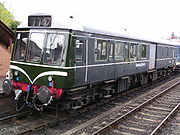 |
| Class 128 British Rail Class 128 British Rail Class 128 was a class of diesel multiple unit, built for British Rail. Introduced in 1959, ten of the class were built by Gloucester Railway Carriage and Wagon Company, each with two 230 hp British United Traction engines. The class was built specifically for parcels, fitted out with... |
Gloucester RC&W 'Parcels' | 2 x Albion 230 bhp | mechanical | parcels | 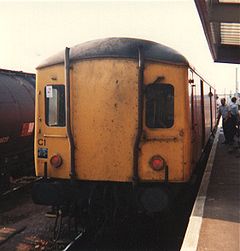 |
| Class 129 British Rail Class 129 The Class 129 was a class of single-car Diesel Multiple Unit built in 1955 for British Rail. Only three were built by Cravens and were introduced in 1958. The class was built for parcels traffic like the Class 128. One unit survived into departmental service being named 'Hydra'... |
Cravens 'Parcels' | 2 x Leyland 150 bhp | mechanical | parcels | http://www.old-dalby.com/images/Hydra-small.jpg |
| Class 130 British Rail Class 116 The British Rail Class 116 diesel multiple units were built by BR Derby from 1957 to 1961.-Regular use:These units stayed in regular service until 1990, when they began to be withdrawn from traffic. They were replaced on regional services by the new "Sprinter" derivative units, or by Class 323... |
Parcels conversion from Class 116 | 2 x Leyland 150 bhp | mechanical | parcels | http://www.railfaneurope.net/pix/gb/diesel/dmu-heritage/130/130_mt.jpg |
| Class 131 British Rail Class 122 The British Rail Class 122 diesel mechanical multiple units were built by Gloucester RC&W in 1958. Twenty single-car driving motor vehicles, called "Bubble Cars", were built, numbered 55000–55019... |
Parcels conversion from Class 122 | 2 x AEC 150 bhp | mechanical | parcels | http://everythingbutthegoyle.fotopic.net/p37630847.html |
Lightweight Railcars
| Class | Manufacturer | Date Built | Number Built | Withdrawn | Image |
|---|---|---|---|---|---|
| Class 139 British Rail Class 139 British Rail Class 139 is the TOPS classification for PPM60 model lightweight railcars built by Parry People Movers, for use on the British rail network... |
Parry People Movers Parry People Movers Parry People Movers Ltd. is a British company manufacturing lightweight trams and railcars that use flywheel energy storage to store energy for traction, allowing electric systems to operate without overhead wires or third rails, and railcars fuelled by small gas, diesel or hydrogen engines,... |
2008 | 2 x single cars | still in use |
Pacers
| Class | Manufacturer | Date Built | Number Built | Withdrawn | Image |
|---|---|---|---|---|---|
| Leyland Railbus Prototypes |
BREL-Leyland | 1978-84 | 4 x single cars | 1980s | 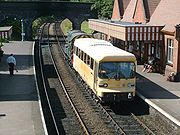 |
| Class 140 British Rail Class 140 The British Rail Class 140 was the prototype of the Pacer diesel multiple unit. Much of the bodywork was constructed using Leyland National bus components, with the exception of the cabs, in 1980.... |
BREL-Leyland | 1980 | 1 x 2-car set | 1981 | |
| Class 141 British Rail Class 141 The British Rail Class 141 was the first production model of the Pacer diesel multiple units.-Description:In the early 1980s British Rail were looking to replace the remaining 1950s first generation Diesel Multiple Units on lightly used branchlines... |
BREL-Leyland | 1984 | 20 x 2-car sets | 1997 | 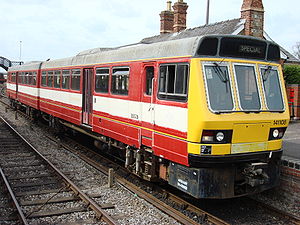 |
| Class 142 British Rail Class 142 The British Rail Class 142 is a class of Pacer diesel multiple units used in the United Kingdom. 96 units were built by BREL in Derby between 1985 and 1987. They were a development of the earlier Class 141 which were introduced in 1984.... |
BREL-Leyland | 1985-87 | 96 x 2-car sets | still in use |  |
| Class 143 British Rail Class 143 The British Rail Class 143 is a diesel multiple unit, part of the Pacer family of trains introduced between 1985 and 1986. They originally worked in the North-East of England but were later transferred to Wales and South-West England.... |
Barclay-Alexander | 1985-86 | 25 x 2-car sets | still in use |  |
| Class 144 British Rail Class 144 The British Rail Class 144 "Pacer" diesel multiple units were built by BREL Derby from 1986-1987. A total of 23 units were built, replacing many of the earlier first-generation "Heritage" DMUs.... |
BREL-Alexander | 1986-87 | 13 x 2-car and 10 x 3-car sets | still in use |  |
Sprinters
| Class | Manufacturer | Date Built | Number Built | Withdrawn | Image |
|---|---|---|---|---|---|
| Class 150 British Rail Class 150 The British Rail Class 150 "Sprinter" diesel multiple units were built by BREL from 1984-87. A total of 137 units were built in three main subclasses, replacing many of the earlier first-generation "Heritage" DMUs.- Background :... |
BREL Sprinter | 1984-87 | 135 x 2-car and 2 x 3-car sets | still in use |  |
| Class 151 British Rail Class 151 The British Rail Class 151 was a prototype class of DMU built by Metro Cammell in the mid-1980s.Only two 3-car units were built and they were introduced into service in the spring and summer of 1985. The vehicles were aluminum bodied and each one was equipped with Cummins NT855 diesel engines with... |
Metro-Cammell prototypes | 1985 | 2 x 3-car units | 1989 |  |
| Class 152 British Rail Class 156 The British Rail Class 156 Super Sprinter is a diesel multiple-unit train . 114 of these units were built from 1987 to 1989 by Metro-Cammell at its Washwood Heath Works in Birmingham... |
Proposed single car conversion of Class 156 | Never built | 0 | Never Built | |
| Class 153 British Rail Class 153 The British Rail Class 153 Super Sprinter is a single car diesel multiple unit converted from British Rail Class 155s.-Description:These units were originally built as two-car Class 155 units by British Leyland from 1987–88, but were converted by Hunslet-Barclay at Kilmarnock from 1991-92... |
BREL-Leyland Super-Sprinter (rebuilt from Class 155) |
1991-92 | 70 single cars | still in use |  |
| Class 154 | BREL Sprinter | 1985 | 3 car unit converted from class 150 | Converted back to class 150 |  |
| Class 155 British Rail Class 155 The British Rail Class 155 Super Sprinter is a diesel multiple unit. These DMUs were built by British Leyland at Workington between 1987 and 1988 as part of British Rail's replacement of its ageing diesel fleet which were First-Generation.- History and description :The Class 155 train is made up... |
BREL-Leyland Super-Sprinter | 1987-88 | 42 x 2-car sets, 7 still in original form | still in use |  |
| Class 156 British Rail Class 156 The British Rail Class 156 Super Sprinter is a diesel multiple-unit train . 114 of these units were built from 1987 to 1989 by Metro-Cammell at its Washwood Heath Works in Birmingham... |
Metro-Cammell Super-Sprinter | 1987-89 | 114 x 2-car sets | still in use |  |
| Class 157 British Rail Class 157 Class 157 was the designation applied to a range of Diesel multiple unit trains of the Sprinter family planned for regional use, in particular for the Strathclyde Passenger Transport Executive... |
Proposed Strathclyde PTE Sprinter | Never Built | 0 | Never Built | |
| Class 158 British Rail Class 158 British Rail Class 158 Express Sprinter is a diesel multiple-unit train, built for British Rail between 1989 and 1992 by BREL at its Derby Works. They were built to replace many locomotive-hauled passenger trains, and allowed cascading of existing Sprinter units to replace elderly 'heritage' DMUs... |
BREL Express | 1989-92 | 165 2-car and 17 3-car sets | still in use |  |
| Class 159 British Rail Class 159 The British Rail Class 159 is a class of diesel multiple unit of the Sprinter family, built in 1989 - 1992 by BREL at the Derby Carriage and Wagon Works as Class 158... |
BREL Express | 1992-93 | 22 3-car sets | still in use |
Networker
| Class | Manufacturer | Date Built | Number Built | Image |
|---|---|---|---|---|
| Class 165 British Rail Class 165 The British Rail Class 165 Turbo is a fleet of suburban diesel multiple units , originally specified by and built for British Rail, the then United Kingdom state owned railway operator. They were built by BREL at York Works between 1990 and 1992... |
BREL Network Turbo | 1990-92 | 48 x 2-car and 28 x 3-car sets |  |
| Class 166 British Rail Class 166 The British Rail Class 166 Turbo Express is a fleet of diesel multiple units , originally specified by and built for British Rail, the then United Kingdom state owned railway operator. They were built by ABB at York Works between 1992 and 1993... |
BREL Network Express Turbo | 1992-93 | 21 x 3-car sets |  |
Turbostar
| Class | Manufacturer | Date Built | Number Built | Image |
|---|---|---|---|---|
| Class 168 British Rail Class 168 The Class 168 Clubman is a diesel multiple-unit train used on services between London and the Midlands.-Description:The units were built in several batches from 1997 onwards. The first batch of units was classified 168/0 under TOPS and resembled the Class 165 units previously built by BREL at York... |
Adtranz/Bombardier Clubman | 1998–2004 | 9 3-car and 10 4-car sets | 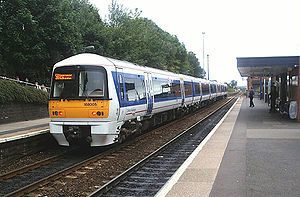 |
| Class 170 | Adtranz/Bombardier Turbostar | 1998–2005 | 44 2-car and 89 3-car sets (to date) |  |
| Class 171 British Rail Class 171 The Class 171 Turbostar is a type of diesel multiple unit built by Bombardier Transportation at their Litchurch Lane Works in Derby, England which is identical to the Class 170, except for the replacement of the BSI coupler with a Dellner coupler... |
Adtranz/Bombardier Turbostar | 2003-04 | 9 x 2-car and 6 x 4-car sets |  |
| Class 172 British Rail Class 172 The Class 172 is a type of diesel multiple unit of the Turbostar family, similar to the Class 168, Class 170 and Class 171.-Technical details and variants :There will be four sub-types:*Class 172/0 - two-car units in operation with London Overground... |
Bombardier Turbostar | 2010- | 24 x 2-car and 15 x 3-car (on order) |
Coradias
| Class | Manufacturer | Date Built | Number Built | Image |
|---|---|---|---|---|
| Class 175 British Rail Class 175 The Class 175 Coradia is a type of diesel multiple unit passenger train used in the United Kingdom. The fleet of 27 sets were built from 1999 to 2001 by Alstom at Washwood Heath in Birmingham. They are part of the Coradia family of trains along with the Class 180.The entire fleet is owned by the... |
Alstom Coradia 1000 | 1999–2001 | 11 x 2-car and 16 x 3-car sets | 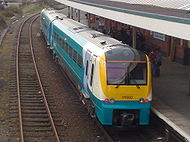 |
| Class 180 British Rail Class 180 The Class 180 is a type of British diesel multiple unit train built by Alstom between 2000 and 2001 for use on then-new express services by First Great Western . They were built at Washwood Heath in Birmingham and are part of the Coradia 1000 family along with the Class 175. FGW stopped using the... |
Alstom Coradia Adelante | 2000–2001 | 14 x 5-car sets |
Desiro
| Class | Manufacturer | Date Built | Number Built | Image |
|---|---|---|---|---|
| Class 185 British Rail Class 185 The Class 185 Pennine Desiro is a diesel multiple-unit passenger train of the Desiro type built by Siemens in Germany for the British train operating company First TransPennine Express.51 units were acquired, representing an investment of £250 million.... |
Siemens Desiro UK | 2005-06 | 51 x 3-car sets |  |
Southern Region DEMUs
| Class | SR code SR multiple unit numbering and classification The Southern Railway created classification and numbering systems for its large fleet of electric multiple units that were perpetuated by the Southern Region of British Rail until the early 1980s, when the impact of TOPS was felt... |
Built | Quantity (sets) | Withdrawn | Image |
|---|---|---|---|---|---|
| Class 201 British Rail Class 201 The British Rail Class 201 six-car diesel-electric multiple units were built in 1957-1958 at Eastleigh and Ashford. They were built for use on the London-Hastings line... |
6S | 1957-58 | 7 x 6-car sets | 1986 |  |
| Class 202 British Rail Class 202 The British Rail Class 202 diesel-electric multiple units were built from 1957-58 at Eastleigh and Ashford Works. These units were built to work the London Charing Cross to Hastings services... |
6L | 1957-58 | 9 x 6-car sets | 1986-87 | |
| Class 203 British Rail Class 203 The British Rail Class 203, initially classified 6B, was a type of diesel electric train. Seven units, numbered 1031-1037, were constructed in 1958 for use on the Southern Region... |
6B | 1958 | 7 x 6-car sets | 1990 | http://www.kentrail.org.uk/class_201_202_203.htm |
| Class 204 British Rail Class 204 The British Rail Class 204 designation has been used twice for two similar types of diesel-electric multiple units.The original units, numbered in the range 1119-1122, were two-car versions of the Class 205 '3H' units, and were classified as 2H under the old system.In 1979, BR decided to augment... |
2H/3T | 1979 (formed using class 205 and 206 cars) | 4 x 3-car sets | 1980s |  |
| Class 205 British Rail Class 205 The British Rail Class 205 diesel-electric multiple units were built by BR at Eastleigh from 1957–1962. They were replaced by Turbostar units.-Description:This class of unit were built in four different batches for use on different lines.... |
2H/3H | 1957-62 | 4 x 2-car and 29 3-car sets | 1992–2004 | 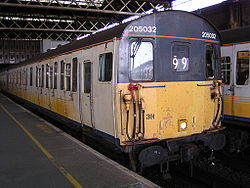 |
| Class 206 British Rail Class 206 The British Rail Class 206 or 3R was a type of Diesel electric multiple unit first created in 1964. They were not 'built' as such but rather re-formed from Class 201 and EPB vehicles for use on -- services... |
3R | 1964 | 6 x 3-car sets (formed using class 201 and 416 cars) | 1979 | 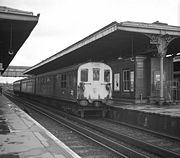 |
| Class 207 British Rail Class 207 The British Rail Class 207 diesel-electric multiple units were built by BR at Eastleigh in 1962.-Technical details:Power car * Introduced: 1962* Weight: 56 tons... |
3D | 1962 | 19 x 3-car sets | 1990–2004 |  |
| Class 210 British Rail Class 210 The British Rail Class 210 was a type of diesel-electric multiple unit built in the late 1970s. The class was intended to be a modern replacement for the ageing 'first generation' types in use on the Southern Region of British Railways but the prototypes built did not manage to secure production... |
1981 | 1 x 3-car and 1 x 4-car set | 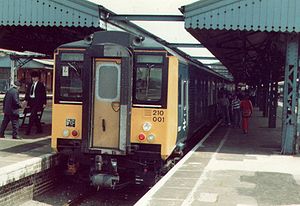 |
Voyager-style express DEMUs
| Class | Manufacturer | Date Built | Number Built | Image |
|---|---|---|---|---|
| Class 220 British Rail Class 220 The Class 220 Voyager are a class of diesel-electric high-speed multiple-unit trains built by Bombardier Transportation in 2000 and 2001.... |
Bombardier Voyager | 2000-01 | 34 x 4-car sets |  |
| Class 221 British Rail Class 221 The Class 221 Super Voyager is a class of British diesel-electric multiple-unit express trains built by Bombardier Transportation between 2001 and 2002, entering service on 12 April 2002.... |
Bombardier Super Voyager | 2001-02 | 4 x 4-car and 40 x 5-car sets |  |
| Class 222 British Rail Class 222 The British Rail Class 222 is a diesel-electric multiple unit high-speed train capable of . Twenty-seven units have been built by Bombardier Transportation.... |
Bombardier Meridian/Pioneer | 2003–05 | 4 x 4-car, 17 x 5-car and 6 x 7-car sets | 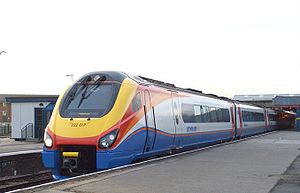 |
High Speed Trains
| Class | Manufacturer | Information | Date Built | Number Built (driving motor cars) | Withdrawn | Image |
|---|---|---|---|---|---|---|
| Class 251/261 | Metro-Cammell | Blue Pullman | 1959-60 | 10 | 1973 |  |
| Class 252 British Rail Class 252 Class 252 was the classification allocated to the prototype High Speed Train unit, numbered 252001.-History:When originally built, in 1972, the prototype High Speed Train units were considered to be formed of two locomotives at either end of a rake of carriages... |
BREL | Prototype HST | 1972 | 2 | 1980s |  |
| Class 253/254 | BREL | HST / InterCity 125 (driving motors reclassified as Class 43 British Rail Class 43 (HST) The British Rail Class 43 is the TOPS classification used for the InterCity 125 High Speed Train power cars, built by BREL from 1975 to 1982.... and trailers as Mk.3 hauled stock British Rail Mark 3 British Rail's third design of standard carriage was designated 'Mark 3' , and was developed primarily for the InterCity 125 High Speed Train... ) |
1976–1982 | 197 | still in use |  |
| Class 255 | BREL | Proposed HST sets for use by Virgin Trains Virgin Trains Virgin Trains is a train operating company in the United Kingdom. It operates long-distance passenger services on the West Coast Main Line between London, the West Midlands, North West England, North Wales and Scotland... on Cross-Country routes |
1976-82 | 0 | Never Built | http://www.uktrainsim.com/filelib-info.php?form_fileid=13752 |
See also
- British Rail locomotive and multiple unit numbering and classificationBritish Rail locomotive and multiple unit numbering and classificationA number of different numbering and classification schemes were used for locomotives and multiple units operated by British Railways , and this page explains the principal systems...
- British Rail coach designationsBritish Rail coach designationsThe London, Midland and Scottish Railway and the London and North Eastern Railway both developed a system of identifying railway carriages by means of alphabetic codes...

